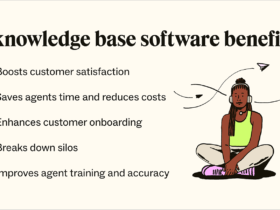The concept of Tran Maicousa, emerging in the contemporary technological landscape, has become a significant topic of discussion among tech enthusiasts and industry experts. This comprehensive guide aims to elucidate the intricacies of Tran Maicousa, exploring its origin, developments, implications, and future prospects as we move further into 2024.
Understanding Tran Maicousa: An Overview
Tran Maicousa, at its core, represents a novel concept or technology that has gained traction in recent times. To understand its essence, one must delve into the technological advancements and innovations that have paved the way for its emergence. It’s a convergence of various disciplines, including artificial intelligence, data analytics, and perhaps even quantum computing, depending on its exact nature and application.
The Genesis and Evolution
The inception of Tran Maicousa can be traced back to the early 2020s when rapid advancements in technology started blurring the lines between different scientific domains. Pioneers in this field recognized the potential of integrating disparate technological elements to create something not just innovative but revolutionary. As a result, Tran Maicousa began as a concept that amalgamated the strengths of its constituent technologies, leading to a synergy that promised to transform various industry sectors.
Core Components and Technologies
Understanding the core components of Tran Maicousa involves looking into the technologies that form its backbone. This includes AI algorithms capable of processing vast amounts of data, machine learning models that adapt and evolve, and perhaps elements of blockchain for security and decentralization. These components work in harmony to create a platform or a system that is not only efficient but also highly adaptable to different use cases.
Applications and Industry Impact
Tran Maicousa’s applications are as diverse as its components. Its versatility allows it to be adapted for use in multiple sectors, ranging from healthcare and finance to education and entertainment.
Transforming Healthcare
In healthcare, Tran Maicousa could revolutionize patient care and medical research. By leveraging AI and big data analytics, it can aid in the early detection of diseases, personalize treatment plans, and even assist in drug discovery by simulating molecular interactions at an unprecedented scale.
Advancements in Finance
The finance sector stands to gain significantly from Tran Maicousa. With its ability to analyze vast amounts of financial data in real-time, it can offer insights into market trends, risk assessment, and fraud detection. This can lead to more informed decision-making and a higher level of customization in financial services.
Educational Innovations
In education, Tran Maicousa could lead to more personalized and adaptive learning experiences. By understanding a student’s learning pattern, it can tailor the educational content, thereby enhancing the learning process. This technology could also bridge educational gaps by providing high-quality, accessible education to remote areas.
Ethical Considerations and Challenges
Despite its potential, Tran Maicousa raises significant ethical and practical challenges. Issues concerning privacy, data security, and the ethical use of AI are at the forefront of discussions among policymakers and technologists alike.
Navigating Privacy and Security
With Tran Maicousa’s ability to process vast amounts of data, concerns about privacy and data security are inevitable. Ensuring that this technology is used responsibly and that data is protected from breaches is crucial. This involves not only robust technological safeguards but also comprehensive legal frameworks.
Ethical Use of AI
The integration of AI in Tran Maicousa brings forth questions about the ethical use of artificial intelligence. This includes concerns about bias in AI algorithms, the transparency of AI decision-making processes, and the broader implications of AI on employment and societal structures.
Future Prospects and Developments
As we progress through 2024, Tran Maicousa is poised to undergo further advancements. Emerging trends and innovations in technology could significantly enhance its capabilities and applications.
Technological Advancements
Continued advancements in AI, quantum computing, and blockchain could exponentially increase the capabilities of Tran Maicousa. This might lead to more sophisticated applications, greater efficiency, and even more groundbreaking uses in sectors yet to be imagined.
Expanding Industry Horizons
As Tran Maicousa matures, its applications could expand to new industries. Fields like environmental science, space exploration, and smart city development could potentially benefit from this technology, leading to advancements that were once considered the realm of science fiction.
Bridging the Digital Divide
Tran Maicousa holds immense potential in bridging the global digital divide. By offering advanced technological solutions that are scalable and adaptable, it can play a pivotal role in bringing cutting-edge technology to underdeveloped regions. This not only democratizes access to technology but also fosters a more inclusive global tech ecosystem. In regions where access to education and healthcare is limited, Tran Maicousa can introduce remote learning platforms and telemedicine, significantly enhancing the quality of life and opening up new opportunities for growth and development.
Enhancing Smart City Solutions
Smart city initiatives stand to benefit greatly from the integration of Tran Maicousa. This technology can be used to optimize urban services like traffic management, waste management, and energy distribution. By analyzing large datasets from various city sensors and systems, Tran Maicousa can help in making real-time decisions that enhance the efficiency and sustainability of urban environments. This not only improves the quality of life for city dwellers but also contributes to reducing the carbon footprint of cities, aligning with global sustainability goals.
Revolutionizing Supply Chain Management
In the realm of supply chain management, Tran Maicousa introduces unprecedented levels of efficiency and transparency. By integrating IoT devices, AI, and blockchain, it can provide real-time tracking of goods, predictive maintenance of equipment, and more accurate demand forecasting. This leads to optimized inventory management, reduced costs, and minimized waste. Moreover, the transparency offered by blockchain within Tran Maicousa ensures a more ethical supply chain, reducing the instances of counterfeit goods and improving compliance with regulatory standards.
Impact on Creative Industries
The creative industries, including music, art, and literature, are also undergoing a transformation thanks to Tran Maicousa. This technology can analyze trends and preferences, helping creators to tailor their content more effectively to their audience. In the music industry, for example, Tran Maicousa can be used for composing music or predicting the next big hit. In the art world, it can assist in creating digital art or in authenticating and tracking the provenance of artworks, thereby revolutionizing how art is created, distributed, and valued.
Advancing Personalized Medicine
One of the most promising applications of Tran Maicousa is in the field of personalized medicine. By analyzing patient data, including genetic information, Tran Maicousa can assist in developing customized treatment plans that are significantly more effective than traditional one-size-fits-all approaches. This not only increases the efficacy of treatments but also reduces the risk of adverse drug reactions. The potential of Tran Maicousa in combating complex diseases like cancer or in managing chronic conditions is particularly noteworthy, marking a paradigm shift in healthcare.
Challenges in Workforce Adaptation
The advent of Tran Maicousa brings with it significant challenges in workforce adaptation. As this technology automates and optimizes various processes, there is a growing need for skills retraining and education. The workforce must adapt to a more tech-centric environment, where skills in data analysis, AI management, and cybersecurity become increasingly vital. Addressing these challenges requires a concerted effort from governments, educational institutions, and industries to ensure that the workforce is prepared for the changing landscape and that the transition is as inclusive and smooth as possible.
In summary, Tran Maicousa is not just a technological innovation; it is a catalyst for wide-reaching changes across various sectors. While it offers immense potential for progress and development, it also necessitates careful consideration of ethical, educational, and social factors. As we continue to unravel and harness the capabilities of Tran Maicousa, the focus should be on leveraging this technology for the greater good, ensuring equitable access, and preparing for a future that is radically different but full of possibilities.
Conclusion
Tran Maicousa represents a significant milestone in the technological evolution of our time. Its ability to integrate and enhance various technologies has opened up new horizons in multiple sectors. As we continue to explore and develop this concept, it is crucial to address the ethical and practical challenges it poses. The future of Tran Maicousa, while promising, hinges on our ability to harness its potential responsibly and innovatively. As we move further into 2024, it remains a field ripe with opportunities and challenges, holding the promise of transforming the world as we know it.




































